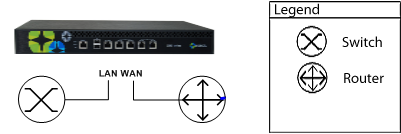Installing an Exinda Virtual Appliance
The Exinda range of unified performance management (UPM) appliances is available as fully featured virtual appliances. There is no difference between the software that runs on bare metal hardware and the software that runs on the virtual appliance. If the Exinda software detects it is running on a hypervisor, it automatically enables certain optimizations to ensure maximum performance.
Exinda provides support for Virtual Appliances running on the following hypervisors:
- VMware vSphere (ESX and ESXi) (5.5 and 6.0)
- Citrix XenServer (6.2 and 6.5)
- Microsoft Hyper-V (Windows Server 2008 R2 and later)
- Linux KVM (Intel VT or AMD-V)
Exinda Appliances deploy the same ways as hardware appliances. For more information refer to Deployment options.
The two typical deployment topologies are in-pathIn-path refers to placing an between network devices that send and receive data packets to each other, like a switch and a router. An appliance deployed in-path automatically inspects all packets traveling along the path. and out-of-path.
Overview of in-path deployment
In-path deployments involve one or more LANLocal area network/WANWide Area Network port pairs bridged together at layer 2. To be monitored and optimized by an Exinda Virtual Appliance, traffic must go through the bridge.
In an in-path topology, an Exinda Virtual Appliance is deployed inlineIn network terminology, an inline device receives packets and forwards them to their intended destination. Routers, firewalls and switches are examples of inline devices. The inline designation also alerts you the device is critical to network function. If the device goes down, network traffic is affected.. Using an image of a hardware appliance to represent a virtual appliance, an inline Exinda Virtual Appliance plugs into the network via the LAN and WAN ports like this:

Inline deployment
The challenge in a virtual environment is deciding how to pass traffic through the bridge. The method you choose depends on your virtual environment and hypervisor.
There are several options:
- Dedicate two physical NICs on the host to be LAN and WAN ports.
- Used shared NICs on the host to be LAN and WAN ports, but logically separate the traffic with VLAN tags.
- Create a virtual network and direct traffic through virtual LAN/WAN ports.
Overview of out-of-path deployment
Out-of-path deployments are typically used in SPAN port mirroring, WCCP, high availability (HA) and clustering scenarios. Using an image of a hardware appliance to represent a virtual appliance, an Exinda Virtual Appliance plugs into the network like this:

Out-of-path deployment
The setup is straightforward, requiring one NIC for management and another for auxiliary.
See the following topic for more information about installing and running an Exinda Virtual Appliance.